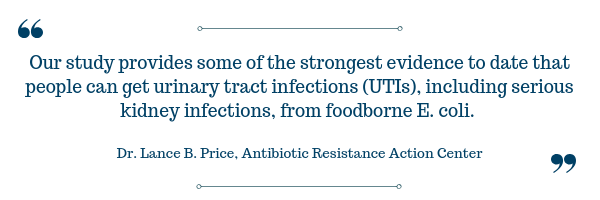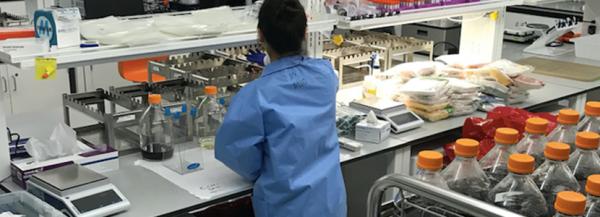Expert Spotlight: 5 Questions with Dr. Lance B. Price
We’re doing something a little different this month! We’re interviewing our Director, Dr. Lance B. Price, about a new paper he and his colleagues recently published in the American Society for Microbiology’s journal mBio. The study, “Escherichia coli ST131-H22 as a Foodborne Uropathogen,” highlights how an E. coli strain from retail poultry may cause urinary tract infections in people. Read the interview below to learn more about what this means and why it’s so significant.
1. Your study found that a strain of Escherichia coli (E. coli) found in retail chicken and turkey products may cause a wide range of infections in people. That’s pretty alarming, can you tell our readers more about the significance of this?
Our study provides some of the strongest evidence to date that people can get urinary tract infections (UTIs), including serious kidney infections, from foodborne E. coli. This has implications for food safety and underscores the potential risks of using antibiotics in food-animal production, since this could potentially lead to antibiotic-resistant UTIs.
2. What prompted you to do this research project?
Our colleagues, Amee Manges, James R. Johnson, Neils Frimodt-Møller, Lee Riley and others, had published groundbreaking research suggesting that foodborne strains of E. coli might pose a risk for UTIs in people, but their work fell short of proving or quantifying the problem. Meanwhile, our own research was showing that one particular strain of E. coli -- called ST131 -- was causing a rapidly increasing number of antibiotic-resistant infections in the U.S. and around the world. With the current study, we set out to determine if foodborne urinary tract infections actually happened, if so, then how often, and, specifically, we wanted to see if meat could be a source of ST131 infections in people.
3. Can you explain how this multi-center research team conducted the research and arrived at the findings? How long from start to finish did this project take?
I’m pretty embarrassed by how long this project took to complete! We cultured E. coli from retail meat and clinical samples for an entire year, from January to December 2012, then we spent the next couple years sequencing the DNA from more than 3,000 E. coli samples, and finally spent another couple years analyzing the data and writing up our findings. While studies of this scale are now becoming more common, at the time, it was unprecedented and took an expansive team to complete. We had people shopping for meat every two weeks, people culturing samples in the lab, people collecting samples in the hospital, reviewing medical records, testing bacteria for antibiotic resistance, sequencing DNA, building databases, building evolutionary trees, scanning genomes for poultry-associated genes, the list goes on and on. The great thing was that everyone on the team was excellent at their particular tasks and shared a commitment to answering this important question.
4. What can people who eat poultry or those who live in homes where people eat it, do to protect themselves from these kinds of infections?
We’re hoping that this research will eventually lead the U.S. Department of Agriculture to find ways to keep these kinds of E. coli out of the food supply. In the meantime, consumers have to recognize that handling poultry could put them at risk for picking up UTI-causing E. coli, so they should handle the products carefully to prevent cross-contamination in the kitchen and cook poultry meat thoroughly. Finally, I always recommend that people seek out poultry products that are labeled “raised without antibiotics”, “no antibiotics ever”, or “organic” to reduce their risk for becoming exposed to antibiotic-resistant bacteria. For institutional buyers, I recommend products with ARAC’s “Certified Responsible Antibiotic Use (CRAU)” label.
5. What will you be tackling next when it comes to E. coli, meat and people?
We estimate that more than 30,000 people may be infected with foodborne E. coli ST131-H22 each year in the U.S. In our next paper, we will provide a comprehensive list of E. coli strains that may be making their way to people through the food supply and estimate the total number of UTIs that may be caused by these strains in the U.S. each year.




